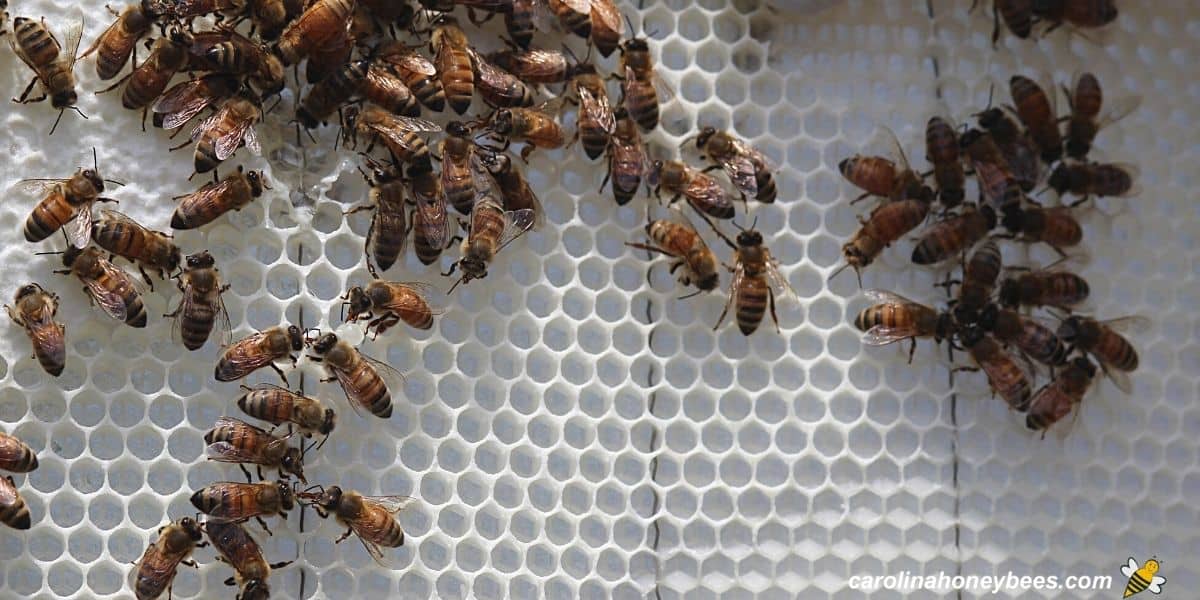Bees Festooning
Festooning bees are like tiny architects inside the beehive. Working together to form long chains of bees – they build some intricate structures for colony use. While we know some things about bees, there are still mysteries to unravel. We have theories for this action of bees festooning among the hive frames. But, much of it is simply educated guesses.

Routine hive inspections help beekeepers understand the condition of the colony. They play a critical role in hive management., And when we see an unusual behavior – of course we want to know why.
What is Festooning?
Festooning bees is a behavior where honey bees hang in a line or chain making a lace type pattern between frames inside a bee hive.
They are attached to one another by a pair of hooks on the bees’ legs – it looks like the bees are holding hands.
It is very interesting to observe bees festooning in the hive for the first time. When you gently pull the frames apart, bees will seem to cling to each side. I can remove two frames with festooning bees in the middle and they may stay connected!

Why do Bees Festoon?
Honestly, this behavior continues to be somewhat of a mystery to beekeepers and research scientists. We are not exactly sure why bees form a festooning pattern.
But there are a few theories:
- makes comb building easier
- they may use it for measuring spaces
- clustered bee bodies produce heat that promotes wax production
Comb Construction
One idea is that the living chain may have something to do with comb construction. Beekeepers who encourage bees to build comb by feeding and other methods understand that it is a big job.
This lacework of hanging worker bees can create new wax comb or repair old comb that has been damaged. Cleaning and repair is a constant job for workers. Anything that makes the job easier would be a plus.
Yet, beekeepers have seen bees festooning in other areas of the hive. Perhaps, there is more than one purpose for this activity?

On theory is that festooning bees are able to recreate sections of comb faster than would be possible by individual bees doing their own thing.
The ladder of bees serves as a sort of scaffolding. Each bee secretes small flakes of wax (called scales) from wax glands on their abdomen. Using their mouth and legs – the wax is shaped into thousands of hexagonal wax cells.
These cells will be used to hold honey and pollen. Some become brood cells and serve as a place to rear young or bee brood. The colony needs plenty of cells to provide space for all these needs.
Measurements
Honey bees are quite particular about where they place frames of comb. We know that they are able to measure spaces inside the hive.
Combs are built in any space larger than 3/8 of an inch “bee space” – perhaps festooning helps bees keep the proper spacing between combs. The colony attempts to fill any open spaces with comb. Perhaps the chain of honey bees is able to calculate measurements?

Concentrated Heat
One possible theory on the purpose of festooning bees is that the cluster or crowded living chain creates more heat. The best temperature for secretion of wax and manipulation is over 91°F.
With hundreds of bees hanging on to each other in a small space, temperatures would certain rise – making wax easier to work with.
This post may contain affiliate links. As an Amazon Associate, I earn from qualifying purchases. Please read my disclosure.
Unknown Origins
Despite these great examples of why bees festooning may be beneficial for the colony – it is not required. We know that honey bees can build comb without hanging in chains with their sisters.
Why do it in some areas and not others? Unless it involves the “size” of the construction area – we just don’t know.
How do they communicate in a way that lets everyone know what to do? This is one of those mysteries we still do not understand completely.
Netting Behavior
Jürgen Tautz is a world-renowned German bee biologist. In one of his latest books – he submits the idea that the chaining bees we see in festooning – may indeed be a carry-over behavior from wild bees.
Wild bees hang in groups around the construction area – forming a kind of net structure. The net does not necessarily have anything to do with actual comb construction but serves other functions perhaps.
If you want to learn more about his thoughts – read: Wild Honey Bees. This is not a beginner beekeeping book but it is a treasure for any bee lover. The photography is outstanding.

FAQs
Bee festooning is an activity where honey bees join together and hang in chains across a space inside the hive.
Festooning takes place inside the beehive. Where bees cling together in long chains. Researchers are not sure why this happens but it may be connected to comb building or repair.
Honey bees are social insects that work together for the good of the colony. We don’t know why they hand together in festooning chains but it is believed to be associated with wax construction.
Final Thoughts
Bees also cling together in a cluster when honey bees swarm. This small cluster shows connected bees but they are not attached in long chains. Why the difference?
If most researchers are unsure – I can’t hope to give a better answer. We do know that this a common behavior in hives during the warm season. One thing is certain, festooning bees are a delightful sight to see in the hive. This is one of the joys of being a beekeeper.

